Complete Solutions to LINKED COMPREHENSION TYPE QUESTIONS of chapter UNSATURATED HYDROCARBONS of Class 12 book with complete answers and questions
| Class 12 | CHEMISTRY |
| Chapter | UNSATURATED HYDROCARBONS |
| OP TANDON | LINKED COMPREHENSION TYPE QUESTIONS |
| Number Of Questions | 21 |
| Academic Year | 2023-24 |
Hydrogenation of alkenes and alkynes takes place in presence of certain catalysts. In Sabatier Senderen's reaction, the addition of hydrogen takes place I presence of Raney nickel catalyst. Platininm and palladium can also be used as catalyst and used in finley divided state. Experimentally, it is observed that less crowded alkenes adsorb `H_(2)` with faster rate. Controlled hydrogenation of alkyne `H_(2)` with faster rate. Controlled hydrogenation of alkyne in presence of Lindlar's catalyst yields cis product i.e., 'cis' alkene. Thus, in presence of Lindlar's catalyst 'syn' addition takes place. The relative rate of hydrogenation follows the order:

Non-terminal alkynes are reduced in presence of Na or Li metal dissolved in liquid ammonia. In this reaction, anti-addition of hydrogen results into the trans-product.
Answer the following questions:
The relative rate of catalytic hydrogenation of following alkenes is:

View SolutionHydrogenation of alkenes and alkynes takes place in presence of certain catalysts. In Sabatier Senderen's reaction, the addition of hydrogen takes place I presence of Raney nickel catalyst. Platininm and palladium can also be used as catalyst and used in finley divided state. Experimentally, it is observed that less crowded alkenes adsorb `H_(2)` with faster rate. Controlled hydrogenation of alkyne `H_(2)` with faster rate. Controlled hydrogenation of alkyne in presence of Lindlar's catalyst yields cis product i.e., 'cis' alkene. Thus, in presence of Lindlar's catalyst 'syn' addition takes place. The relative rate of hydrogenation follows the order:

Non-terminal alkynes are reduced in presence of Na or Li metal dissolved in liquid ammonia. In this reaction, anti-addition of hydrogen results into the trans-product.
`H_(3)C-C-=C-CH_(3)+H_(2) overset(Pd//CaCO_(3))underset("Boiling Quinoline")to (A)`
The product (A) will be:
View SolutionHydrogenation of alkenes and alkynes takes place in presence of certain catalysts. In Sabatier Senderen's reaction, the addition of hydrogen takes place I presence of Raney nickel catalyst. Platininm and palladium can also be used as catalyst and used in finley divided state. Experimentally, it is observed that less crowded alkenes adsorb `H_(2)` with faster rate. Controlled hydrogenation of alkyne `H_(2)` with faster rate. Controlled hydrogenation of alkyne in presence of Lindlar's catalyst yields cis product i.e., 'cis' alkene. Thus, in presence of Lindlar's catalyst 'syn' addition takes place. The relative rate of hydrogenation follows the order:

Non-terminal alkynes are reduced in presence of Na or Li metal dissolved in liquid ammonia. In this reaction, anti-addition of hydrogen results into the trans-product.
In which of the following cases, the reaction is most exothermic?
View SolutionHydrogenation of alkenes and alkynes takes place in presence of certain catalysts. In Sabatier Senderen's reaction, the addition of hydrogen takes place I presence of Raney nickel catalyst. Platininm and palladium can also be used as catalyst and used in finley divided state. Experimentally, it is observed that less crowded alkenes adsorb `H_(2)` with faster rate. Controlled hydrogenation of alkyne `H_(2)` with faster rate. Controlled hydrogenationof alkyne in presence of Lindlar's catalyst yields cis product i.e., 'cis' alkene. Thus, in presence of Lindlar's catalyst 'syn' addition takes place. The relative rate of hydrogenation follows the order:

Non-terminal alkynes are reduced in presence of Na or Li metal dissolved in liquid ammonia. In this reaction, anti-addition of hydrogen results into the trans-product.
The product of the following reaction is:

View SolutionHydrogenation of alkenes and alkynes takes place in presence of certain catalysts. In Sabatier Senderen's reaction, the addition of hydrogen takes place I presence of Raney nickel catalyst. Platininm and palladium can also be used as catalyst and used in finley divided state. Experimentally, it is observed that less crowded alkenes adsorb `H_(2)` with faster rate. Controlled hydrogenation of alkyne `H_(2)` with faster rate. Controlled hydrognetation of alkyne in presence of Lindlar's catalyst yields cis product i.e., 'cis' alkene. Thus, in presence of Lindlar's catalyst 'syn' addition takes place. The relative rate of hydrogenation follows the order:

Non-terminal alkynes are reduced in presence of Na or Li metal dissolved in liquid ammonia. In this reaction, anti-addition of hydrogen results into the trans-product.
Powdered nickel is more effective than grannular nickel because:
View SolutionOxidation without clevage of sigma bond takes place in alkenes.

Presence of unsaturation in alkenes is detected by using Baeyer's reagent. Alkenes decolourise pink colour of Baeyer's reagent. In presence of Baeyer's reagent, 'syn' addition of -OH groups takes place on both carbons of double bond. The net reaction can be given as,
`R-CH=CH-R overset(KMnO_(4))underset(OH^(-))to R-overset(OH)overset(|)(CH)-overset(OH)overset(|)(CH)-R`
Ozonolysis of alkenes gives ozonide, which on further hydrolysis gives aldehyde and/ or ketone.

Answer the following questions:
Liner polyenes on ozonolysis gives two moles of acetaldeyde and one mole of propanedial. Linear polyene will be:
View SolutionOxidation without clevage of sigma bond takes place in alkenes.

Presence of unsaturation in alkenes is detected by using Baeyer's reagent. Alkenes decolourise pink colour of Baeyer's reagent. In presence of Baeyer's reagent, 'syn' addition of -OH groups takes place on both carbons of double bond. The net reaction can be given as,
`R-CH=CH-R overset(KMnO_(4))underset(OH^(-))to R-overset(OH)overset(|)(CH)-overset(OH)overset(|)(CH)-R`
Ozonolysis of alkenes gives ozonide, which on further hydrolysis gives aldehyde and/ or ketone.
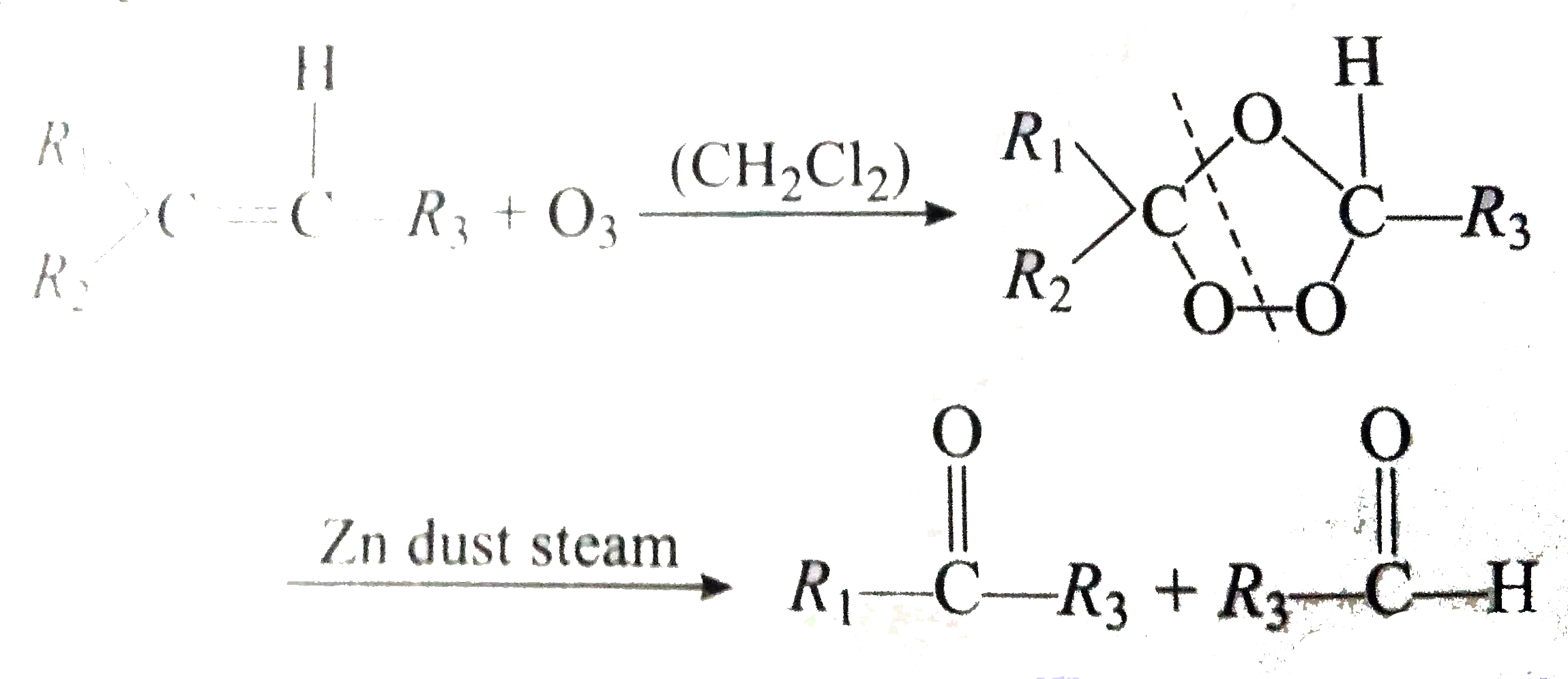
ortho Xylene on reductive ozonolysis will be:
View SolutionOxidation without clevage of sigma bond takes place in alkenes.

Presence of unsaturation in alkenes is detected by using Baeyer's reagent. Alkenes decolourise pink colour of Baeyer's reagent. In presence of Baeyer's reagent, 'syn' addition of -OH groups takes place on both carbons of double bond. The net reaction can be given as,
`R-CH=CH-R overset(KMnO_(4))underset(OH^(-))to R-overset(OH)overset(|)(CH)-overset(OH)overset(|)(CH)-R`
Ozonolysis of alkenes gives ozonide, which on further hydrolysis gives aldehyde and/ or ketone.

Which of the following will give only formaldehyde on ozonolysis?
View SolutionOxidation without clevage of sigma bond takes place in alkenes.

Presence of unsaturation in alkenes is detected by using Baeyer's reagent. Alkenes decolourise pink colour of Baeyer's reagent. In presence of Baeyer's reagent, 'syn' addition of -OH groups takes place on both carbons of double bond. The net reaction can be given as,
`R-CH=CH-R overset(KMnO_(4))underset(OH^(-))to R-overset(OH)overset(|)(CH)-overset(OH)overset(|)(CH)-R`
Ozonolysis of alkenes gives ozonide, which on further hydrolysis gives aldehyde and/ or ketone.
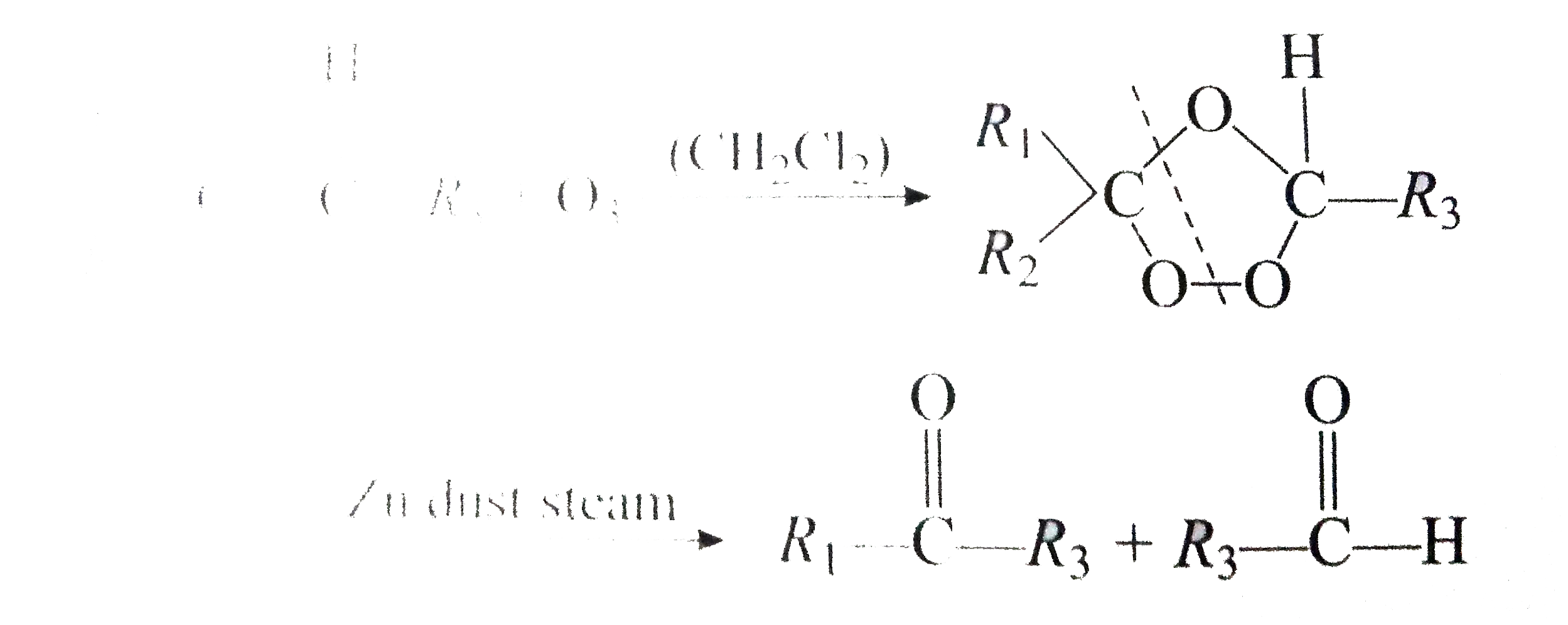
Which of these compounds give glyoxal only on ozonolysis?
View SolutionOxidation without clevage of sigma bond takes place in alkenes.

Presence of unsaturation in alkenes is detected by using Baeyer's reagent. Alkenes decolourise pink colour of Baeyer's reagent. In presence of Baeyer's reagent, 'syn' addition of -OH groups takes place on both carbons of double bond. The net reaction can be given as,
`R-CH=CH-R overset(KMnO_(4))underset(OH^(-))to R-overset(OH)overset(|)(CH)-overset(OH)overset(|)(CH)-R`
Ozonolysis of alkenes gives ozonide, which on further hydrolysis gives aldehyde and/ or ketone.
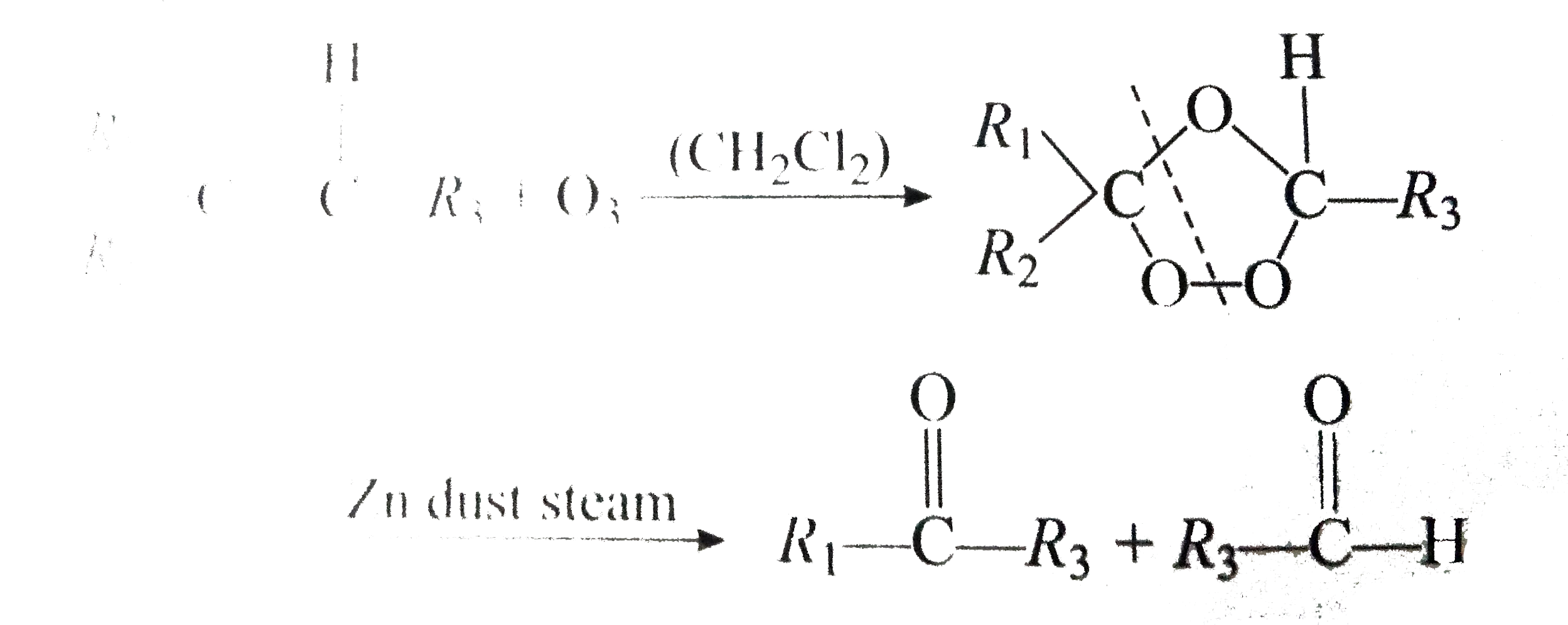
Product of ozonolysis gives information about:
View SolutionOxidation of alkenes by cleavage with the acidic or alkaline `KmNO_(4)` of acidic `K_(2)Cr_(2)O_(7)` at higher temperature yields products depending upon the nature of alkene. A hot solultion of `KMnO_(4)` is a strong oxidising agent which gives only ketones and carboxylic acids and not aldehydes (as they cannot be isolated).

Oxidation of alkenes with `OsO_(4)` followed by alcoholic `NaHSO_(3)` or `Na_(2)SO_(3)` yeilds glycols.

Answer the following questions:
Which of these compounds on oxidation with hot `KMnO_(4)` gives only butanoic acid?
View SolutionOxidation of alkenes by cleavage with the acidic or alkaline `KmNO_(4)` of acidic `K_(2)Cr_(2)O_(7)` at higher temperature yields products depending upon the nature of alkene. A hot solultion of `KMnO_(4)` is a strong oxidising agent which gives only ketones and carboxylic acids and not aldehydes (as they cannot be isolated).
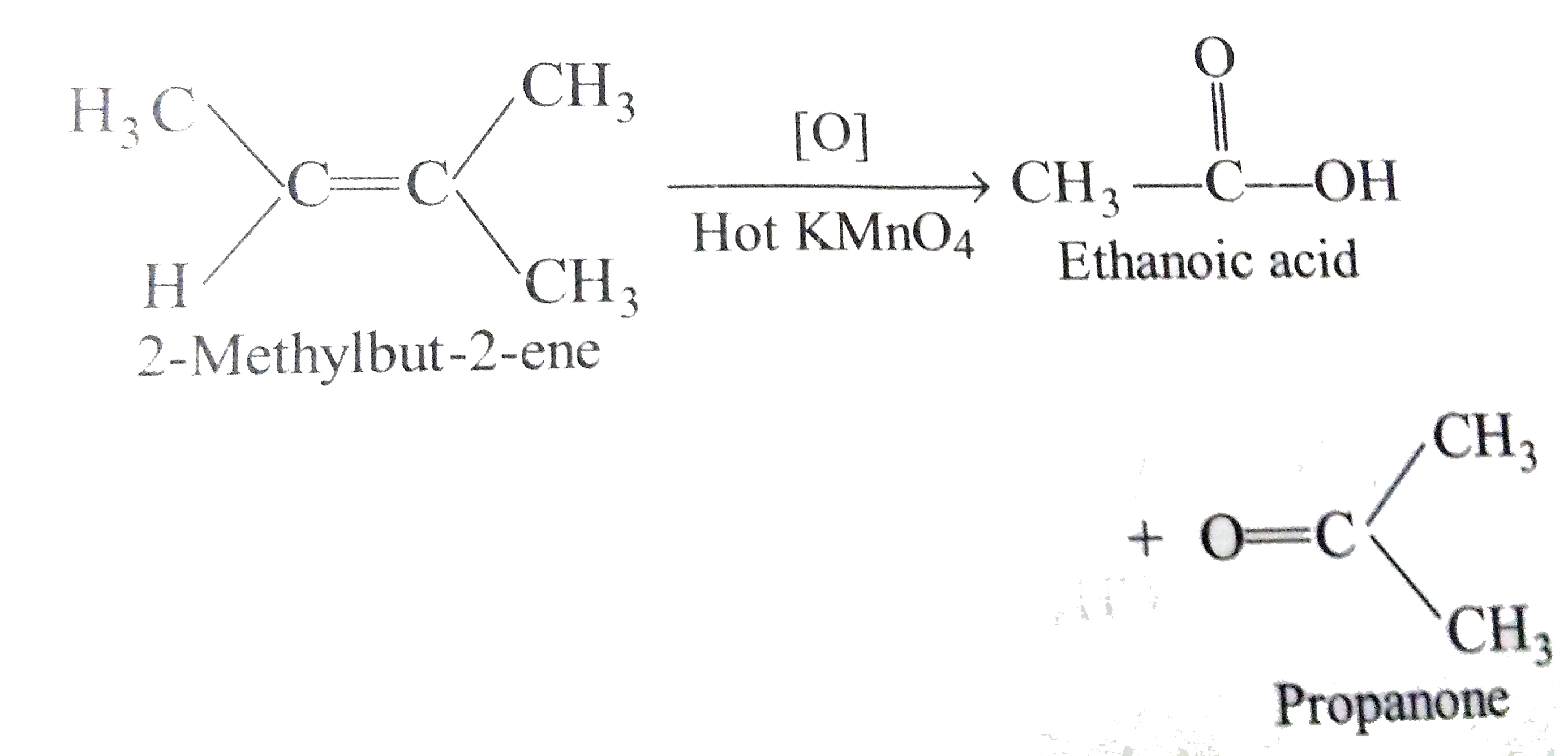
Oxidation of alkenes with `OsO_(4)` followed by alcoholic `NaHSO_(3)` or `Na_(2)SO_(3)` yeilds glycols.
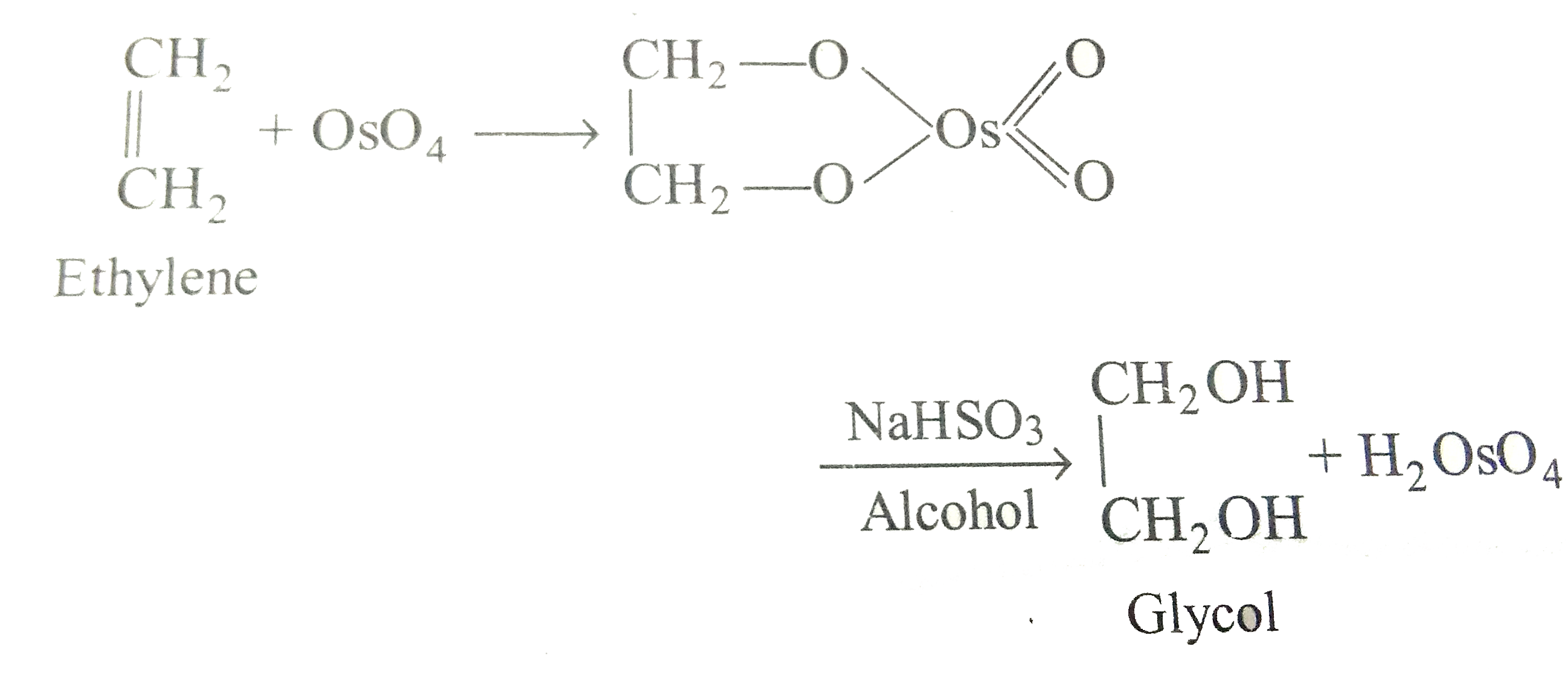
Answer the following questions:
Which of the following compounds on treatment with `OsO_(4)`, followed by `Na_(2)SO_(3)` will give cis-2-methyl butan-2,3-diol?
View SolutionOxidation of alkenes by cleavage with the acidic or alkaline `KmNO_(4)` of acidic `K_(2)Cr_(2)O_(7)` at higher temperature yields products depending upon the nature of alkene. A hot solultion of `KMnO_(4)` is a strong oxidising agent which gives only ketones and carboxylic acids and not aldehydes (as they cannot be isolated).
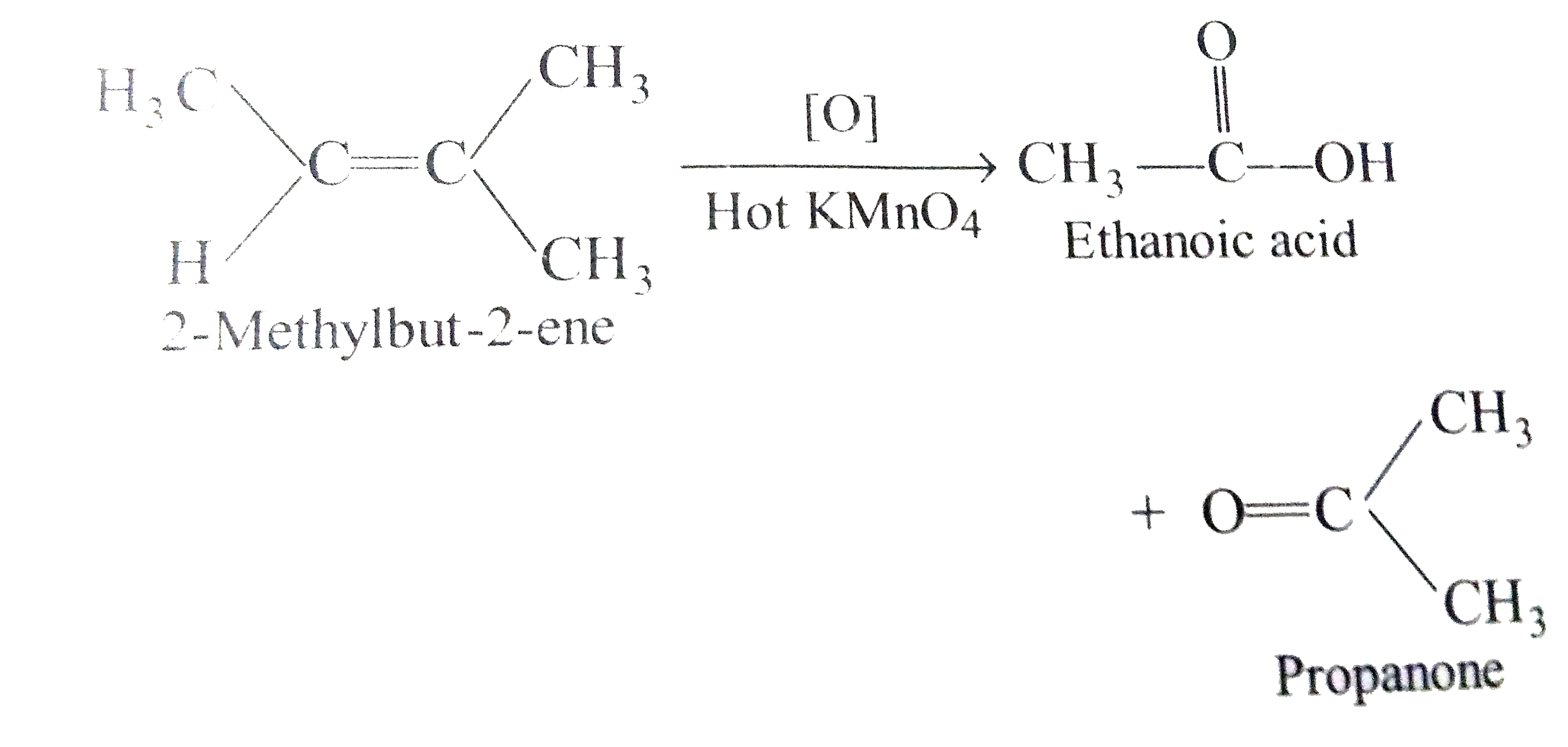
Oxidation of alkenes with `OsO_(4)` followed by alcoholic `NaHSO_(3)` or `Na_(2)SO_(3)` yeilds glycols.
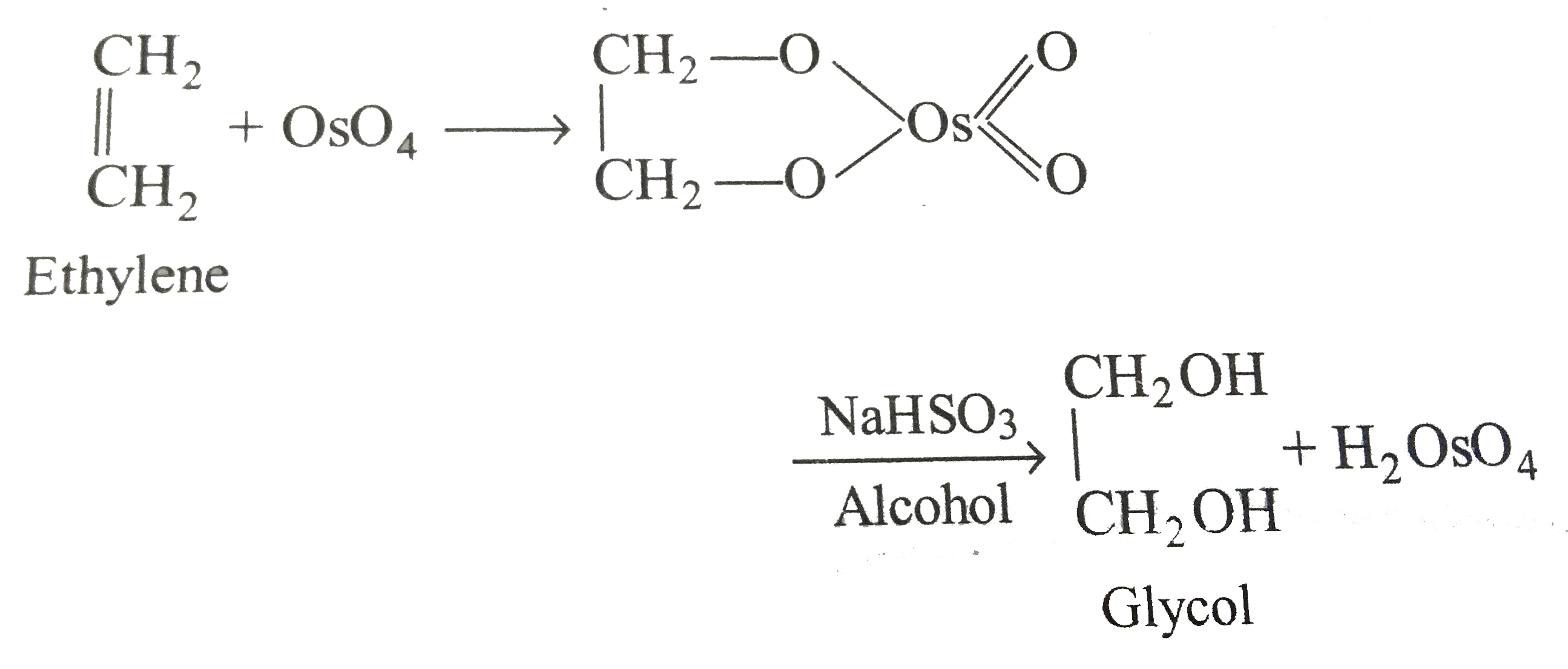
Answer the following questions:
An alkene 1-methyl cyclohexene on oxidation with hot basic `KMnO_(4)` gives:
View SolutionOxidation of alkenes by cleavage with the acidic or alkaline `KmNO_(4)` of acidic `K_(2)Cr_(2)O_(7)` at higher temperature yields products depending upon the nature of alkene. A hot solultion of `KMnO_(4)` is a strong oxidising agent which gives only ketones and carboxylic acids and not aldehydes (as they cannot be isolated).
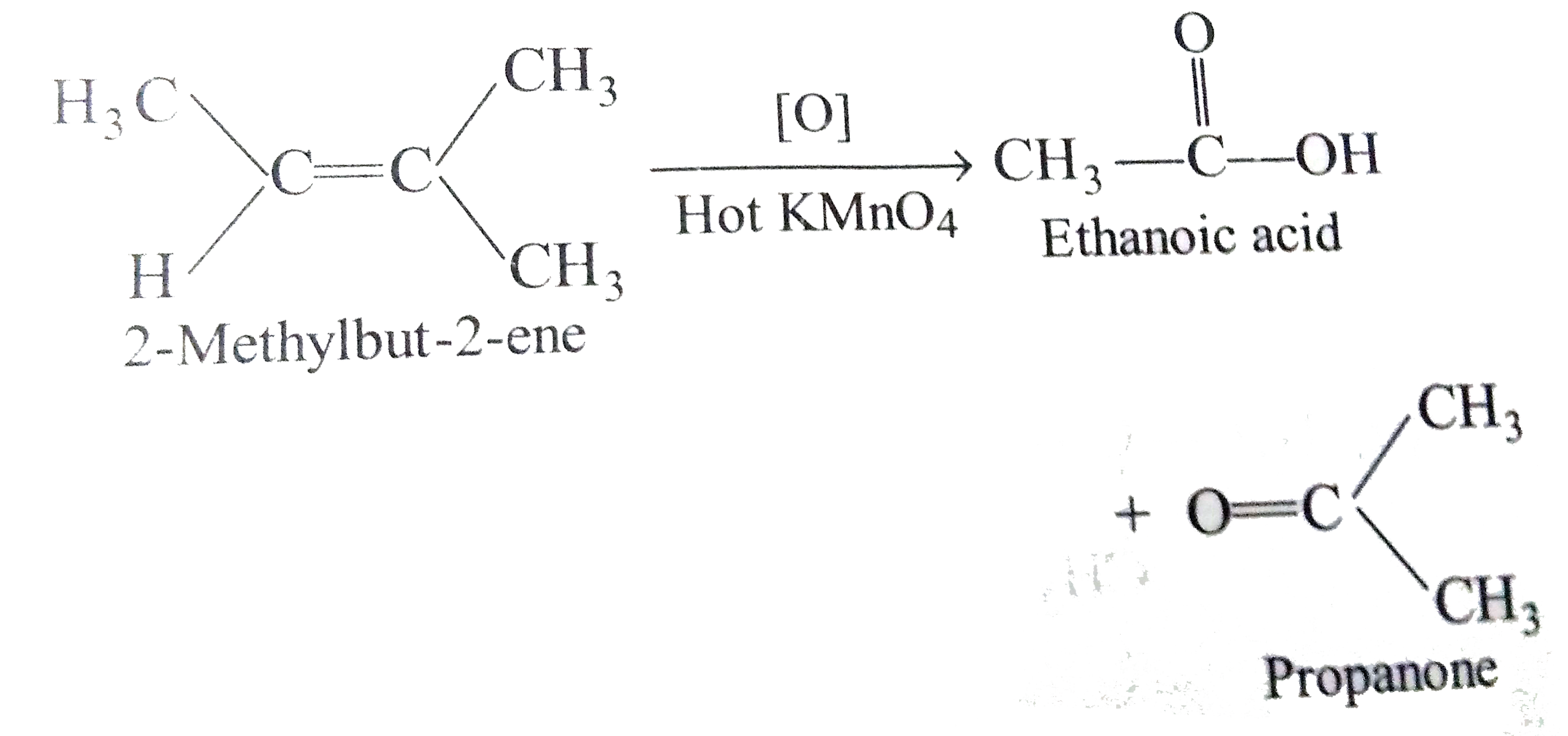
Oxidation of alkenes with `OsO_(4)` followed by alcoholic `NaHSO_(3)` or `Na_(2)SO_(3)` yeilds glycols.
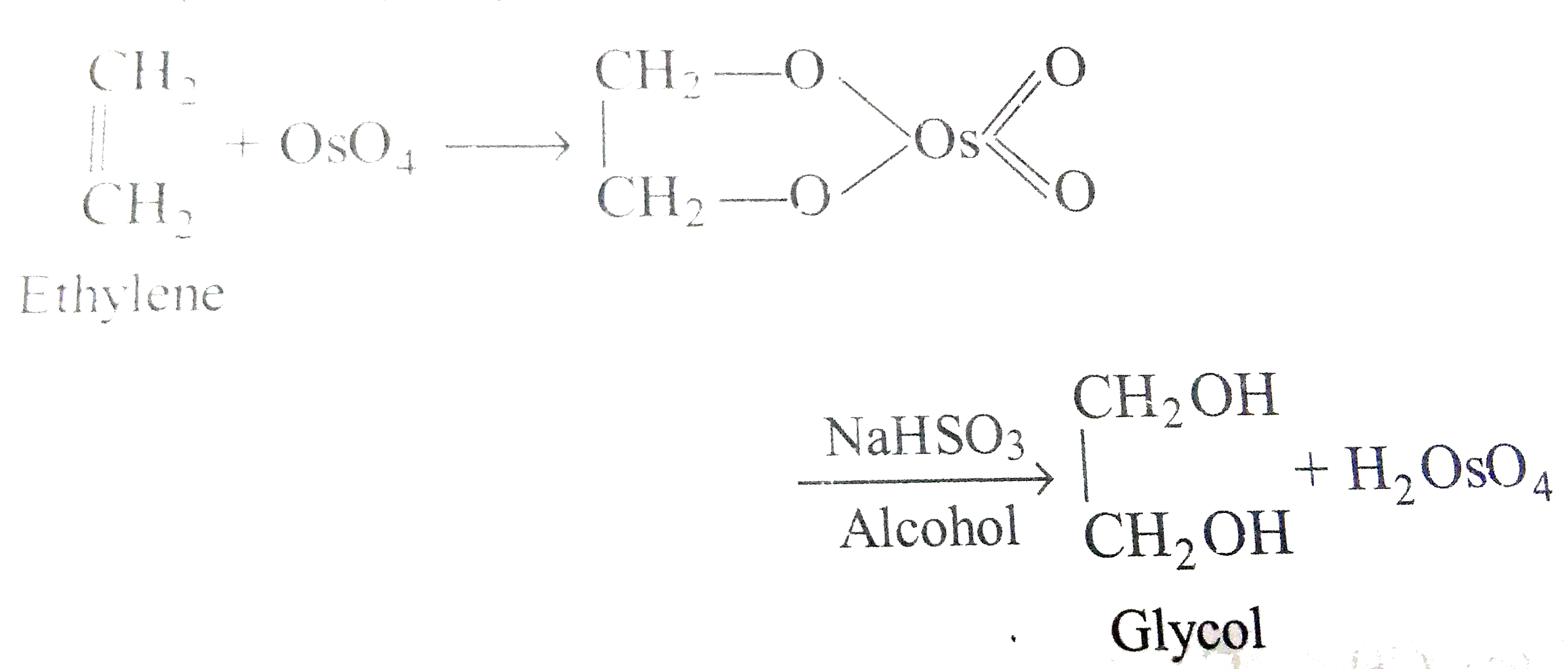
Answer the following questions:
Which of the following alkenes on oxidation with hot `KMnO_(4)` gives cyclopentanone?
View SolutionOxidation of alkenes by cleavage with the acidic or alkaline `KmNO_(4)` of acidic `K_(2)Cr_(2)O_(7)` at higher temperature yields products depending upon the nature of alkene. A hot solultion of `KMnO_(4)` is a strong oxidising agent which gives only ketones and carboxylic acids and not aldehydes (as they cannot be isolated).

Oxidation of alkenes with `OsO_(4)` followed by alcoholic `NaHSO_(3)` or `Na_(2)SO_(3)` yeilds glycols.

Answer the following questions:
An alkene 1,2-dimethyl cyclobutene on oxidation with hot `KMnO_(4)` gives:
View SolutionAn alkene (A), `C_(5)H_(12)` on chlorination at `300^(@)`C gives a mixture of four different monochlorinated derivatives,(B), ( C), (D) and ( E) Two of these derivatives give the same stable alkene (F) on dehydrogenation. On oxidation with hot alkaline `KMnO_(4)`, followed by acidification, (F) gives two products ketone (G) and carboxyclic acid (H).
Answer the following questions:
The structure of compound (A) is:
View SolutionAn alkene (A), `C_(5)H_(12)` on chlorination at `300^(@)`C gives a mixture of four different monochlorinated derivatives,(B), ( C), (D) and ( E) Two of these derivatives give the same stable alkene (F) on dehydrogenation. On oxidation with hot alkaline `KMnO_(4)`, followed by acidification, (F) gives two products ketone (G) and carboxyclic acid (H).
Answer the following questions:
The structure of compounds (G) and (H) are respectively:
View SolutionAn acylic hydrocarbons P, having molecular formula `C_(6)H_(10)`, gave acetone as the only organic product through the following sequence of reactions, in which Q is an intermediate organic compound.
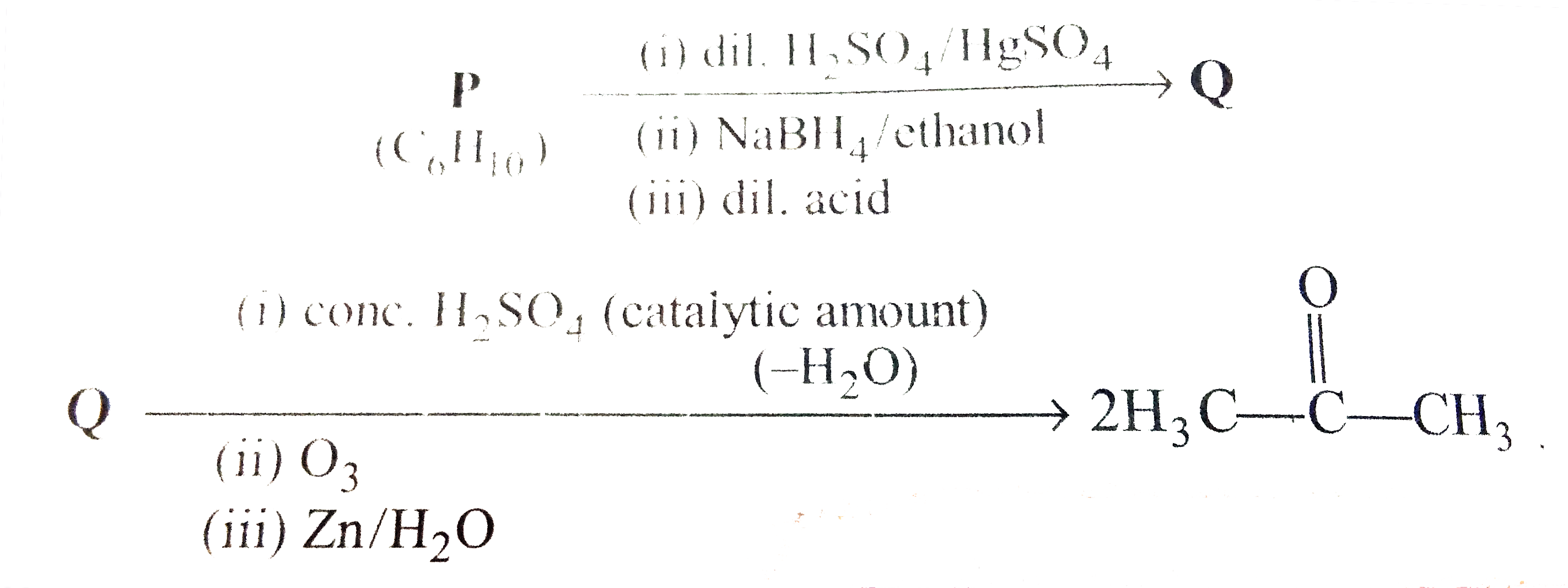
Answer the following questions:
The structure of compound P is:
View SolutionAn acylic hydrocarbons P, having molecular formula `C_(6)H_(10)`, gave acetone as the only organic product through the following sequence of reactions, in which Q is an intermediate organic compound.

Answer the following questions:
The structure of compound Q is:
View SolutionIn the following reactions
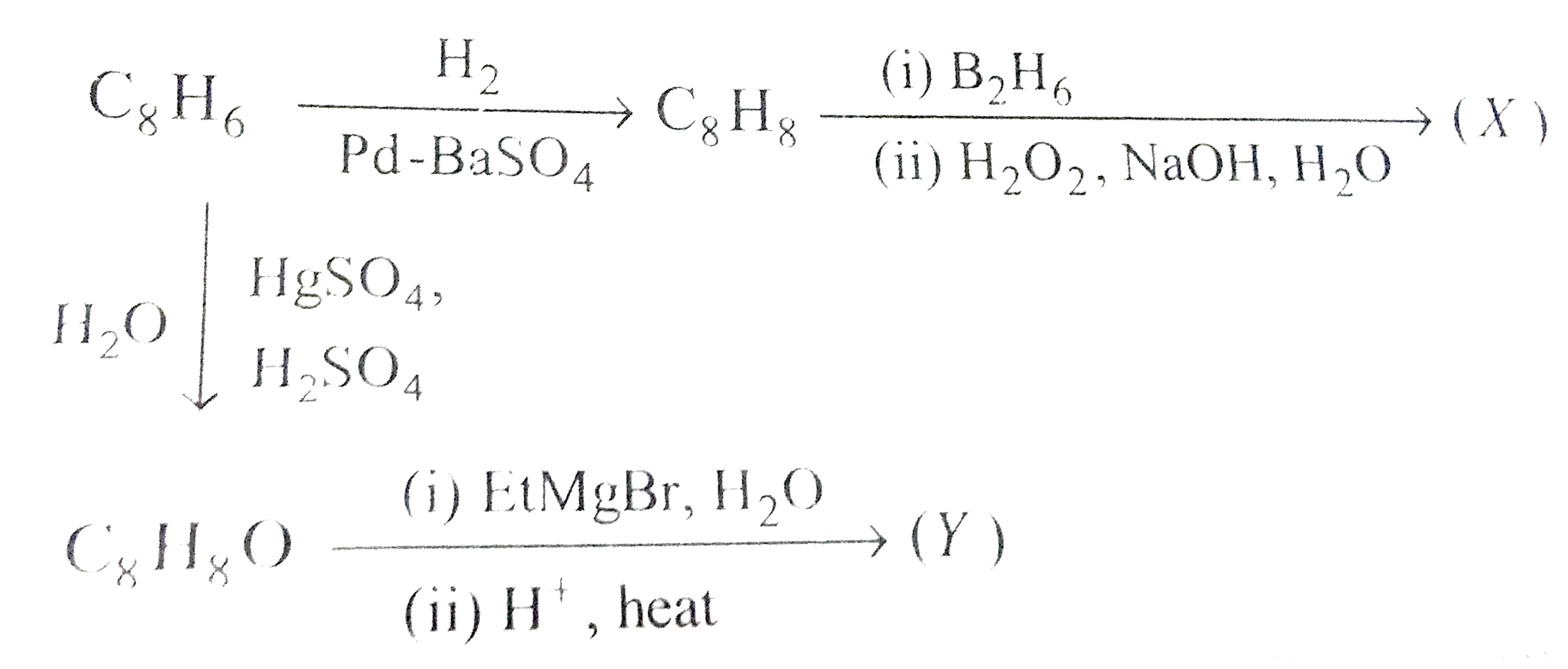
Answer the following questions:
View SolutionIn the following reactions
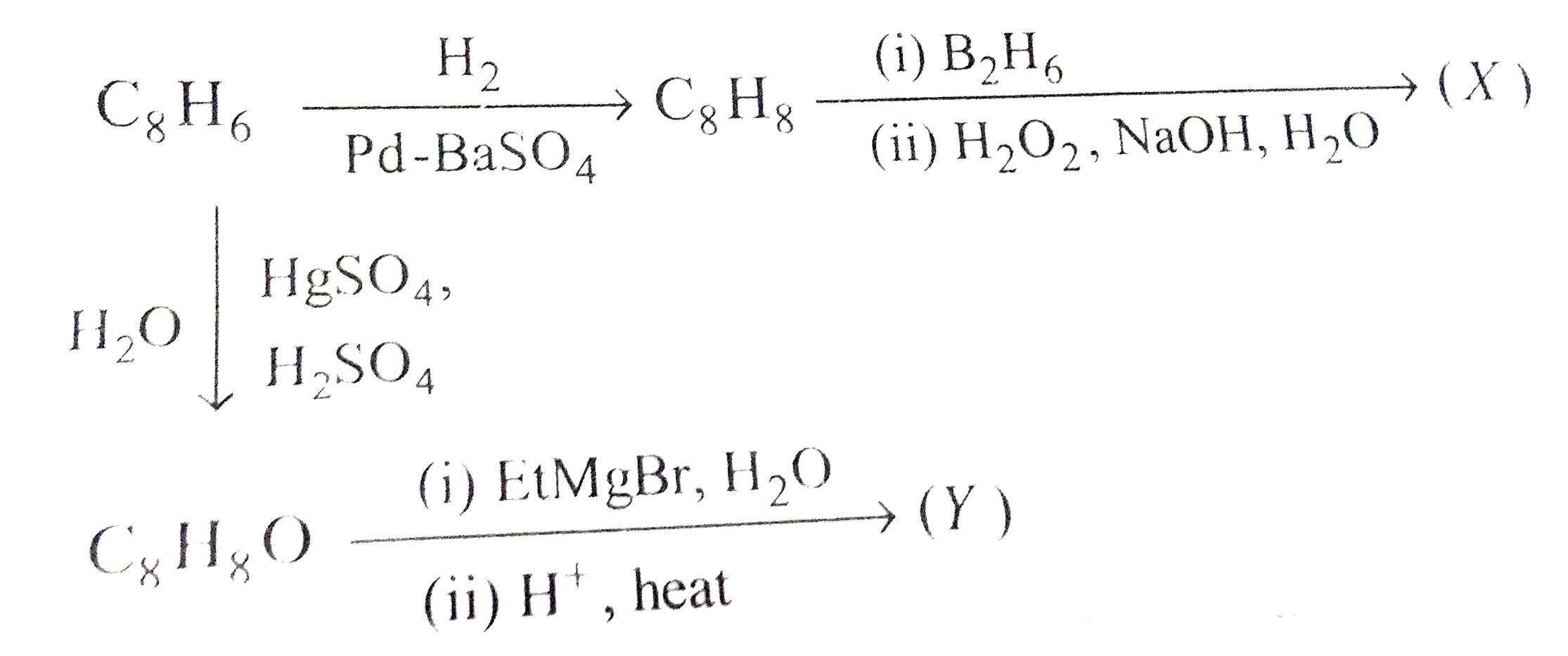
Answer the following questions:
The major compound (Y) is:
View Solution
LINKED COMPREHENSION TYPE QUESTIONS questions and complete solutions for chapter UNSATURATED HYDROCARBONS of G.R. BATHLA & SONS CHEMISTRY (HINGLISH) of Class 12
All Exercises from OP TANDON Class 12 CHEMISTRY UNSATURATED HYDROCARBONS
- (LEVEL B) OBJECTIVE QUESTIONS
- ASSERTION-REASON TYPES QUESTIONS
- BRAIN STORMING PROBLEMS
- ILLUSTRATION OF OBJECTIVE QUESTIONS
- LINKED COMPREHENSION TYPE QUESTIONS
- Match type
- MATRIX MATCH TYPE QUESTIONS:
- OBJECTIVE QUESTIONS
- PROBLEMS BASED ON STRUCTURE AND PROPERTIES
- PROBLEMS FOR PRACTICE
- SET II This set contains the questions with more ..
- SINGLE INTEGER ANSWER TYPE QUESTIONS
- SOME SOLVED PROBLEMS